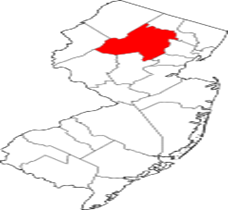Morris County, NJ

From Wikipedia, the free encyclopedia
Morris County is a county located in the U.S. state of New Jersey, about 25 mi (40 km) west of New York City. According to the United States 2010 Census, the population was 492,276. It is part of the New York Metropolitan Area. Its county seat is Morristown.
Morris County was the eighth-wealthiest county in the United States by median household income, and ranked tenth by per capita income. It is the ninth-wealthiest county in the United States by personal per-capita income, the highest rank in New Jersey. The county ranked third in the New York Metropolitan area in terms of median income.
Etymology
Morris County was named after Colonel Lewis Morris, governor of New Jersey in 1738/9, the year the county was named.
Pre-Columbian
The area of Morris County was inhabited by the Lenape prior to the coming of the Europeans. They lived along the rivers and hunted game, fished, collected plants and nuts.
From 1611 to 1614, the Dutch established the colony of New Netherland, which claimed territory between the 40th and 45th parallels, which included northern New Jersey.
The Native Americans traded furs and food with the Dutch for various goods. In return the Dutch gave the Native Americans metal pots, knives, guns, axes, and blankets. Trading with the Native Americans occurred until 1643 when a series of wars broke out between the Dutch and Native Americans due to various disagreements and misconceptions.
There were hostile relations between the Dutch and Native Americans between 1643 and 1660. This prevented colonization by the Dutch of the Morris County region which was technically included in their claimed “New Netherland.”
On August 27, 1664, three English ships approached Fort Amsterdam and the fort was surrendered to the English. The English now controlled New Netherland and Morris County was now under control of the colony of New York. Relations with the Native Americans improved for a while.
There was a war with the Dutch ten years later. The Dutch re-took control of New Amsterdam but after a year returned it to the English. Relations with the Native Americans and English improved for a while.
European settlements began in the early 18th century while it was known as Hunterdon County. Native Americans were still in the area at that time. Land was purchased from the Native Americans for various things such as blankets, shirts, rum, guns, knives, pots and gun powder. The Native Americans’ concept of selling land was different than that of the Europeans. Colonization occurred along the Atlantic coast and moved inland.
The first settlement in the area today known as Morris County occurred in Pompton Plains by the Dutch in 1695. From 1710 to 1730, various iron mines and forges were established. The first was in Whippany in 1710 and then in Succasunna in 1713.
By 1750, nearly all Native Americans had left New Jersey. This was due to land purchases from the Native Americans, diseases that the Native Americans contracted from Europeans, and due to starvation from the Little Ice Age. During the Little Ice age, Native American corn crops failed and rivers froze, preventing fishing. Snow storms sent game into semi-hibernation or made them difficult to find. Nut crops such as oak, hickory, beech, walnut, chestnut and butternut failed some years due to late frosts in spring. Due to all the events that happened, Native Americans went to eastern Canada and others went to the Ohio Valley. The Walking Purchase in September 1737 prevented Native Americans from going to eastern Pennsylvania. At that time, European settlement grew swiftly as there was now land to be farmed and settled.
Morris County was created on March 15, 1739, from portions of Hunterdon County. The county was named for the Governor of the Province of New Jersey, Colonel Lewis Morris. In later years Sussex County (on June 8, 1753) and, after the revolution, Warren County (on November 20, 1824, from portions of Sussex County) were carved out of what had been the original area of Morris County under English rule.
The county was the site of the winter camp of the Continental Army after the Battles of Trenton and Princeton during the winter of 1777, as well as another winter camp at Jockey Hollow during an extremely cold winter of 1779-80 which occurred during the Little Ice Age.

